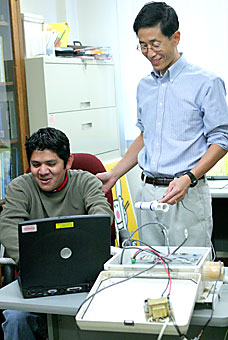 |
|
Courtney Smith/Arizona Daily Wildcat
|
Agriculture and biosystems engineering graduate student Pedro Romero, left, and agriculture
and biosystems engineering professor Chris Choi test equipment used to determine how pathogens spread in drinking water systems in the Center for Advancing Microbial Risk Assessment. UA scientists received a $10 million research grant to develop danger-detection and warning methods for public drinking water systems in the event of a terrorist attack or accident.
|
|
|
By Djamila Grossman
Arizona Daily Wildcat
Wednesday, November 2, 2005
Print this
Three UA scientists in conjunction with seven other universities received a $10 million research grant to focus on the security of drinking water systems in the event of a terrorist attack or accident.
The Department of Homeland Security and the Environmental Protection Agency awarded the five-year grant Oct. 24 for universities to develop danger-detection and warning methods of public drinking water systems, said Ian Pepper, UA professor and director of the UA National Science Foundation Water Quality Center.
"Ultimately we want to be able to make sure that we can provide consumers with safe, healthy water," Pepper said.
The first share of the grant totals $1.2 million that directly benefits the research at the UA, Pepper said.
Tucson Water, the state Legislature, the College of Agriculture and Life Sciences, the office of the vice president for research and other corporations provided an additional $1.8 million to the project.
Together these funds have helped create a research "Water Village" facility called the Center for Advancing Microbial Risk Assessment, which is being built at the environmental research lab, Pepper said.
He said the lab is designed to be a "one-of-a-kind" place to test and measure pathogens in near-real-life conditions, and for collaboration between industry, academia, engineering and environmental science.
By combining these concepts, the research group will be able to better determine how exactly pathogens spread in drinking water systems, said Christopher Choi, associate professor of agricultural and biosystems engineering.
Once they find out how they spread, the researchers will be able to trace the pathogens back to their origin and to assess the affected area, Choi said. By understanding a pathogen source, the researchers will be able to identify a potential danger.
"When that incident happens, we can give an early warning signal to prevent an outbreak and the first responder can understand how to act during an emergency," Choi said. "We would like to create and quantify a model that people can use anywhere in the country."
The focus on water security skyrocketed after the Sept. 11, 2001, terrorist attacks, Pepper said.
"In the post 9/11 world, homeland security tries to be proactive," Pepper said. "How likely is it? We don't know. Can we prepare for the case if it happens? Yes we can."
Research in the Water Village, which comprises four houses, two of which are already operating, will focus on water safety, health and aesthetics, Pepper said.
The other universities participating in the study are Michigan State University, Northern Arizona University, University of Michigan, Drexel University, Carnegie Mellon University and University of California, Berkeley.
These universities will also research issues that will eventually tie into the water issue, but the UA Water Village is the test-bed facility where all results come together, Pepper said.
"If I stood back and looked at the whole picture, I'm very proud of the National Science Foundation Water Quality Center," Pepper said. "The reception nationally to the Water Village is amazing. It takes us to the next level."
Daniel Quintanar, a project manager with Tucson Water, said the company is involved in the Water Village because it provides a space for testing, investigation and research in providing safe water.
While Tucson Water has always implemented a security program to respond to vandals, it has been more focused on drafting an emergency plan for terrorist attacks or accident-related water contamination since the 2001 terrorist attacks, Quintanar said.
"We are trying to look at all those things and come up with a system," Quintanar said. "Things change. It's important for any city to be better prepared."
